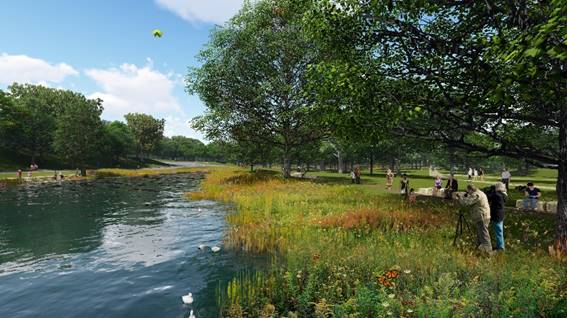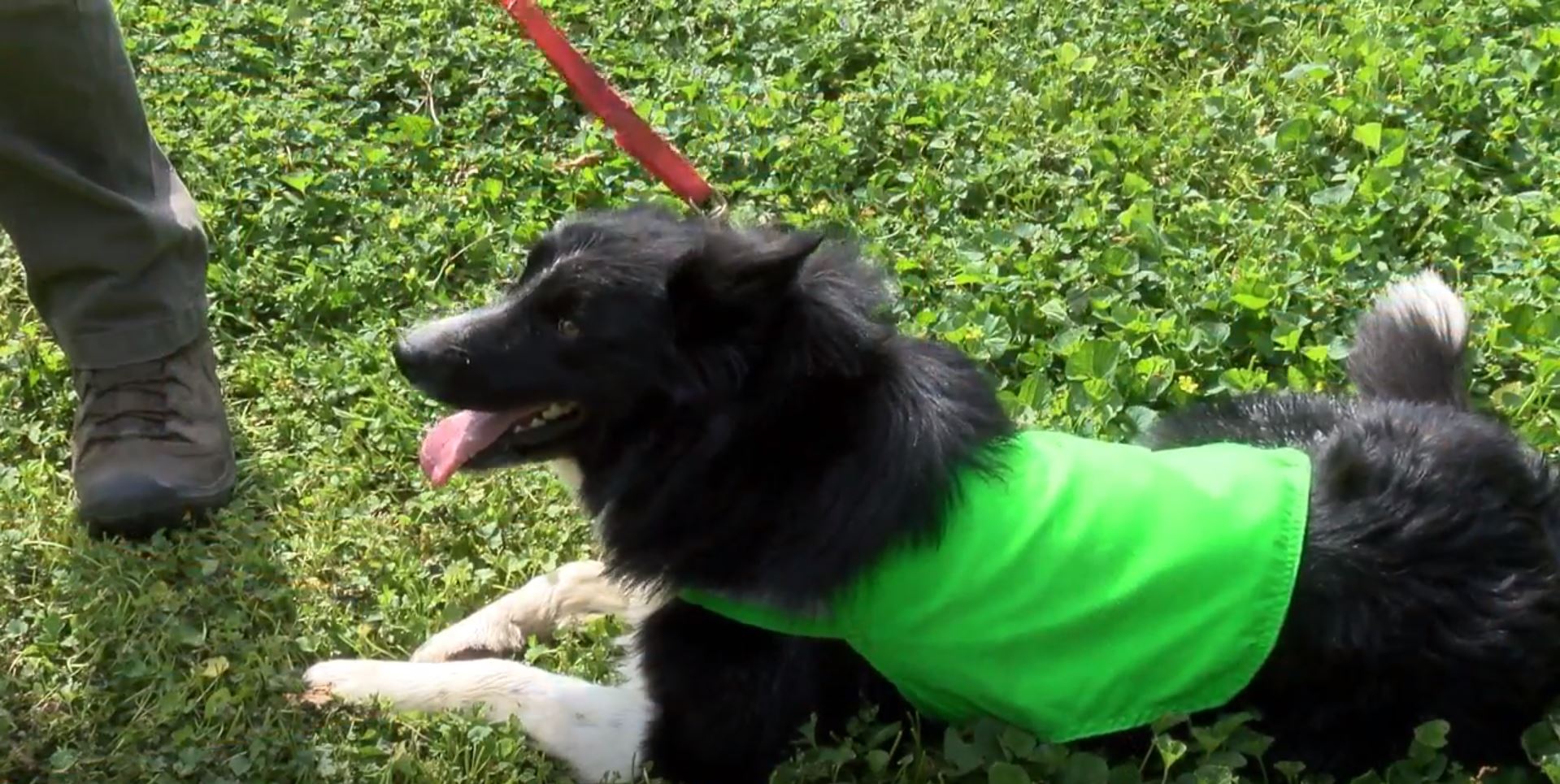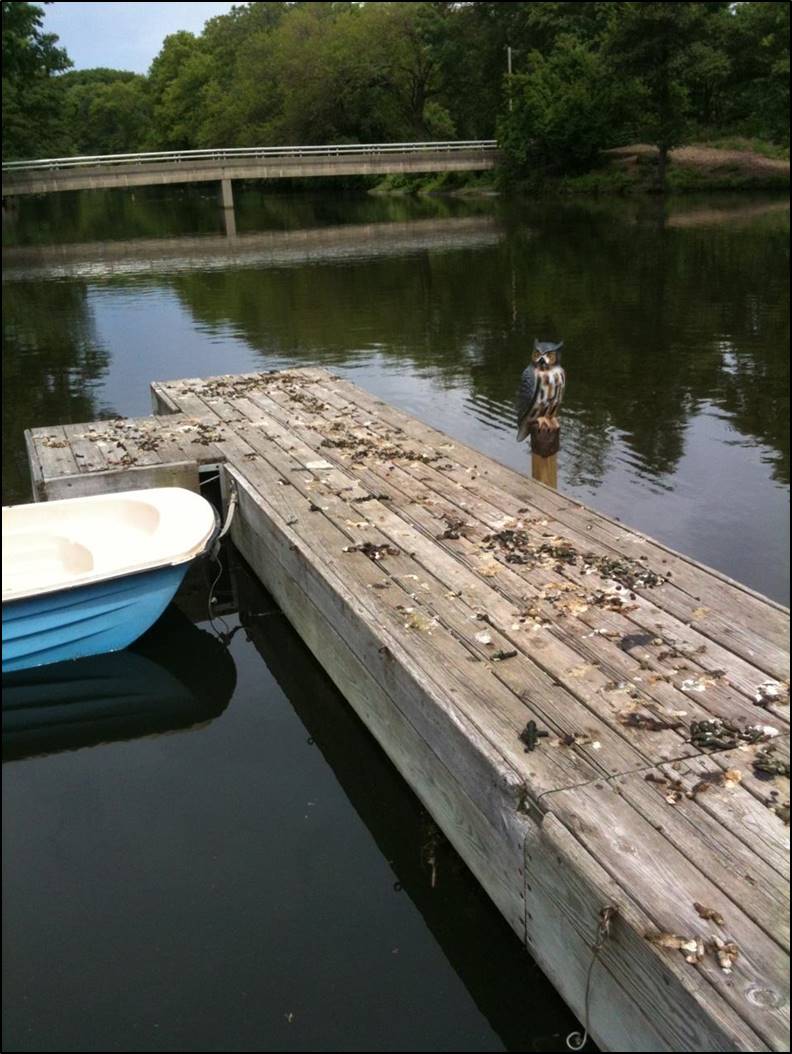Crystal Lake Park Canada Geese Population and Management
2021 Update
Lake Rehabilitation
After many years of planning and design, including input from the Urbana Park District’s Advisory Committee (UPDAC), the district’s Natural Areas Committee (NAC), a Lake Rehabilitation and Access stakeholder group, and several public open houses and surveys, the park district embarked upon a $2.5+ million rehabilitation of the lake and surrounding park land. The lake restoration plan included the removal of extensive invasive brush along the lake edge and the replanting of native grasses and wildflowers as well as the planting of many native trees and shrubs. The planting plan was reviewed by NAC as well as leadership from the Champaign County Audubon Society. Plantings will be monitored and adjusted or expanded as needed. Long term, the native grass buffer along the lake edge will reduce attractiveness of the lake to resident Canada Geese and more diverse plantings will provide habitat for an expanded group of birds, pollinators, and other wildlife. The plan also included installing several limestone outcroppings to provide lake access for fishing and a public kayak/canoe launch.

A rendering of the restored shoreline and lake improvement work in 2020.
Goose Management
In addition to restoring the lake edge and providing lake access, we received a permit from the Illinois Department of Natural Resources (IDNR) and entered into an agreement with USDA Wildlife Services to perform a charity harvest in 2020, or a cull, to reduce the impacts of resident Canada geese on the park and lake. This was not an action we took lightly and was only performed after many years of increasingly intensive management efforts to limit the impacts of geese on the park (see below for more background and history). The harvest reduced the population from over 180 to 35 birds, and numbers continue to fluctuate today.
In order to make sure the remaining birds and any new arrivals remain at a sustainable level for as long as possible, we are continuing our efforts to manage the population. We use hazing methods including trained dogs, radio controlled boats, and lasers to limit goose activity in areas of the park where they are less welcome, such as the recently seeded grasses and wildflowers. Spray repellents are also used to limit geese in these areas as well as near paths and docks. Remaining geese are encouraged through the absence of hazing to nest on the south island primarily and to use the turf on the adjacent sled hill for grazing. Staff monitor nesting locations and use an egg and nest management method endorsed by the humane society and permitted by IDNR to halt egg development before they become viable. Park staff are additionally coordinating with surrounding landowners with goose habitat to assist in nest management in an attempt to prevent the park population from expanding due to offsite nesting. Through all these approaches, we will continue to strive to maintain a sustainable population for years to come.

Meet Max—a specially trained border collie that helps haze and herd geese in Crystal Lake Park.
What can you do? Please Do Not Feed the Geese.
Feeding the geese is harmful in many respects. Feeding contributes to pollution in the park and poor water quality. Geese that are frequently fed can lose their fear of people or even become aggressive. Feeding geese white bread, popcorn, crackers, and other “people food” can lead to malnutrition, illness, and deformities. Geese that are fed are more likely to become overcrowded and have altered migratory behavior. There are plenty of natural feeding options for geese in the park—please don’t harm the geese and the park through feeding.

Background and History
As the Urbana Park District’s 1907 founding park, Crystal Lake Park has long been a place for enjoying nature and wildlife. We work hard to provide quality habitat for birds and other wildlife which reside in the park and will always be a key part of what makes Crystal Lake Park so unique and enticing to visitors.
Within the last decade, we were seeing a rising population of resident Giant Canada Geese in Crystal Lake Park. Exciting to see, and fun to watch, the population was an asset to the park initially. These particular Canada Geese live in the park year round, enjoying the easy access to water and lack of predators the park provides. Other species of Canada Geese stop in the park during their migration in the spring and fall, but these resident geese do not migrate. In early summer of 2020, there were over 180 Canada Geese making the nine acre lake their home. Every spring, each nesting pair typically lays 5-8 eggs. Without the management we undertake, the population would continue growing exponentially.
As the population continued to rise, negative impacts began happening on the park and we began management efforts in an attempt to limit the impacts. Once a novel sight to see, the overabundant goose population began degrading Crystal Lake Park. Each goose deposits over 1 pound of feces per day, leading to public and employee health concerns, unpleasant and slippery pathways, and poor water quality. Shoreline habitats around the lake, and turf grass within the park, have been grazed and degraded leading to erosion and poor turf quality for visitors to the park. Lastly, the increased goose population has led to neighbor concerns and traffic issues in the park and along Park Street, Broadway Avenue, and even University Avenue.

Goose feces throughout the park is a concern for both the employees who must clean it, and visitors to the park alike. Feces also washes into the lake and is one contributor to nuisance algae growth.
Since 2012, we have spent substantial time and resources managing the goose population in a wide variety of ways. This has included everything from signage discouraging feeding geese, beacon lights, sprays and repellents, predator decoys, fencing, Illinois Department of Natural Resources permitted egg and nest management, dog and laser hazing, and habitat modification. See below for more information and a timeline on goose management tactics.
We never intend to eliminate Giant Canada Geese from Crystal Lake Park. A part of nature and what makes the park great, the population can be an asset to the park. However, despite our ongoing and intensified management efforts, the impacts continued and concerns from the public persisted. After many years of public input, planning, and design, we invested over $2.5 million into shoreline restoration, habitat improvements, water quality improvements, and new recreational amenities such as a expanded boat dock, fishing outcroppings and a new playground in 2020. More than ever, it is the most important time to continue increased management efforts to ensure the goose population is controlled and new landscaping and park improvements are protected from degradation.
Charity Harvest/Geese Collection and Donation Summer 2020
After six years of egg and nest management, and many other management strategies, we continued to receive complaints from park visitors, we observed decreasing water quality in the lake, and the park was experiencing other issues associated with an overabundance of geese. We consulted with IDNR and USDA WS determined the park was eligible for a Charity Harvest. In addition to discussions with UPDAC and NAC, staff sought public input through an online survey because COVID-19 prevented us from facilitating an in-person meeting. The survey was advertised through signs in the park, a press release, various email listserves, and social media notifications. The survey received nearly 900 responses over a 30 day period. View the final results of the survey. Comments were recorded and shared with the Board of Commissioners. We also prepared a Frequently Asked Questions document developed in response to the many thoughts and comments that were noted in survey responses.
We moved forward with a Charity Harvest in Summer 2020. The Illinois Department of Natural Resources administered the Charity Harvest program and issued the permit for the collection and culling of geese to take place. The United States Department of Agriculture Wildlife Services conducted the collection and harvest of geese in late June. They reported 175 geese were humanely collected, transported to a poultry processing facility, and then donated as processed meat to a food bank in northern Illinois close to where the processing took place. Since the harvest has been performed, it does not mean Canada Geese have been fully removed from Crystal Lake Park. In fact, it means that the geese remaining within the park have higher quality habitat and created a safer experience for geese and humans alike. The day of the collection, 35 of the collected geese were released back into the park and their numbers continue to fluctuate as the geese continue to move in and out of the park. Management efforts will continue to maintain a reduced population that is in better balance with the ecology of the lake and surrounding park.
A timeline of goose management in Crystal Lake Park
2012 - Goose beacons installed in the lake, proved effective in year 1.
2013 - Beacon habituation, no longer effective.
2014 - Urbana Park District Advisory Committee recommends increased management
Park district hosts area agency lunch and learn with
Illinois Department of Natural Resources Urban Waterfowl Manager
to help gather what other options are available for goose management.
2015 - Park district seeks public input on egg and nest management, public supportive.
- Training on egg and nest management, 1st year (59 nests/ 118 nesting geese)
- Turf application of chemical deterrents.
- Coyote decoy hazing.
- Physical exclusion (limited fencing) installations in high impact areas.
- Ropes along boat dock and bungee cords on boats added to block access to boats.
2016 - 2nd year of nest management (44 nests/ 88 nesting geese). Ongoing turf deterrents
and decoy hazing, exclusion through limited fencing.
2017 - Environmental education programming on the Canada Goose and
negative impacts of feeding them
- 3rd year of nest management (50 nests/ 100 nesting geese). Ongoing turf deterrents
and decoy hazing, exclusion through limited fencing.
2018 - Training and implementation of dog and laser hazing, both which mimic predators of geese.
- Dock and deck application of chemical deterrents.
- 4th year of nest management (43 nests/ 86 nesting geese). Ongoing turf deterrents,
exclusion through limited fencing
2019 - Lake rehabilitation engineering for habitat modification.
- 5th year of nest management (39 nests/ 78 nesting geese).
Ongoing deck/dock/turf deterrents, dog/laser hazing, exclusion through limited fencing.
2020 - UPD hosts area agency lunch and learn with Illinois Department of Natural Resources
Urban Waterfowl Manager and U.S. Department of Agriculture Wildlife Services.
- UPD begins lake rehabilitation project and habitat modification:
$2.5+ million investment on lake and park amenities.
- 6th year of nest management. (29 nests/58 nesting geese. Possible early nests missed due to staff in COVID-19 quarantine).
- Ongoing deck/dock/turf deterrents, dog/laser hazing,
exclusion through limited fencing.
- Charity Harvest reduced park population from over 180 down to 35 geese.
- Shoreline restoration begins, regrading and planting tall native grasses
to make lake less accessible to geese
2021 - 7th year of nest management. (15 nests/ 30 nesting geese)
- Expanded nest management to surrounding landowners.
- Ongoing deck/dock/turf deterrents, dog/laser hazing, exclusion through limited fencing.
- Shoreline plantings establishing modified habitat and goose deterrent.